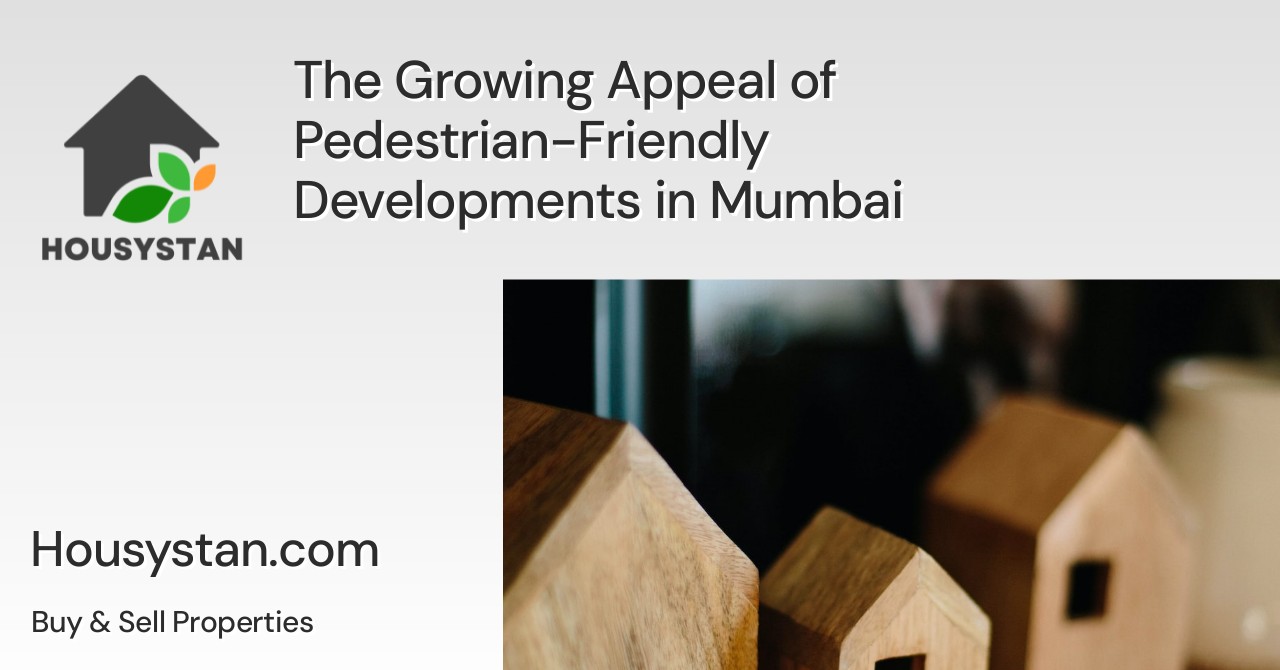The Growing Appeal of Pedestrian-Friendly Developments in Mumbai
Read latest blogs and articles from Housystan

The Information mentioned here was last updated on:
27/11/2025The Growing Appeal of Pedestrian-Friendly Developments in Mumbai
Mumbai, often referred to as the city that never sleeps, has long been associated with bustling traffic, crowded streets, and an ever-growing population. It’s a city where time never stands still. Yet, amid the hustle and bustle, a wave of change is sweeping through. This change is marked by the rising popularity of pedestrian-friendly developments—a shift that promises to alter the urban landscape dramatically.
Understanding the Pedestrian-Friendly Movement
- Verified Tenants/Buyers
- Unlimited Property Listing
- Zero subscription/charges fee
Pedestrian-friendly developments focus on creating urban spaces that prioritize walking over vehicular transport. This concept goes beyond building sidewalks; it seeks to transform whole neighborhoods and cities into places where walking is safe, easy, and enjoyable. Such development plans typically include wider, well-maintained pathways, shaded streets, parklets, pedestrian-only zones, and traffic-calming measures.
In Mumbai, the advantages of pedestrian-friendly areas are becoming increasingly apparent. These areas aim to enhance public spaces, improve air quality, and provide an overall better quality of life for residents.
Increasing Demand for Walkability
One of the primary factors driving the demand for pedestrian-friendly spaces is the public's increasing desire for convenience and quality urban living. In a city famed for its chaotic traffic and long commutes, the appeal of walkable areas is undeniable. People are starting to favor neighborhoods where they can move around effortlessly, without relying on cars or being stuck in traffic jams.
This shift in preference is fueled by awareness about the benefits of walking, not just for physical health but also for mental well-being. Studies consistently show that regular walking can reduce stress, improve heart health, and enhance mood. These benefits, combined with environmental awareness and a push for sustainable living, are bolstering support for pedestrian-friendly urban designs.
Economic Benefits of Walkable Communities
Economic considerations play a significant role in the growing attention towards pedestrian-friendly areas. Walkable neighborhoods often experience a surge in local business activities. As people stroll through these areas, they are more likely to stop at local shops, cafes, and restaurants. This pedestrian foot traffic can lead to increased economic opportunities for small businesses, fostering a sense of community and local culture.
Moreover, properties located in walkable areas usually see an increase in market value. Prospective buyers and renters are often willing to pay more for the convenience and lifestyle such areas offer. As a result, developers and city planners are increasingly recognizing the financial viability of investing in pedestrian-friendly infrastructure.
Challenges in Implementing Pedestrian-Friendly Developments
Despite the evident advantages, transforming Mumbai into a pedestrian paradise comes with its challenges. The city's existing infrastructure, designed decades ago, primarily catered to vehicular transportation without foreseeing the current demand for walkability. Introducing pedestrian-oriented changes requires substantial modifications to existing roads and public spaces, which can be logistically complex and costly.
There is also the challenge of cultural change. For decades, Mumbai residents have been accustomed to certain modes of transportation. Encouraging a shift towards walking involves changing perceptions and habits—a process that takes time and consistent effort from both the public and policymakers.
Initiatives and Success Stories in Mumbai
There have already been successful initiatives in Mumbai that highlight the potential of pedestrian-friendly developments. The popular Carter Road promenade in Bandra is a prominent example—offering residents a scenic, automobile-free walkway where they can exercise, socialize, or simply enjoy the view. Similar efforts are underway in other parts of the city.
The Mumbai Urban Transport Project is another government initiative focusing on urban development projects aimed at improving pedestrian spaces. These projects include new foot overbridges, enhanced crosswalks, and the introduction of dedicated pedestrian pathways in congested areas.
Furthermore, local communities have played a pivotal role by advocating for better pedestrian infrastructure. Grassroots movements have been instrumental in influencing policy changes, demonstrating the power of collective citizen action.
Global Inspiration and Urban Design
Mumbai's pedestrian-friendly initiatives draw inspiration from cities across the globe. Urban centers like Tokyo, New York, and Amsterdam are renowned for their pedestrian-friendly infrastructure. These cities illustrate how pedestrian-centric designs contribute to vibrant public spaces and improved quality of life. By studying these examples, Mumbai can learn valuable lessons in creating a city that balances both vehicular and pedestrian needs.
Incorporating elements such as pedestrian plazas, vehicle-free streets, and shared spaces could significantly enhance the city's walkability. Partnerships between city planners, architects, and environmentalists will be crucial in bringing these transformative ideas to life.
Environmental Impact and Sustainability
A critical factor behind the push for pedestrian-friendly developments is the need to address environmental concerns. With urban pollution reaching alarming levels, reducing vehicle dependency can contribute significantly to cleaner air. By promoting walking as a primary mode of transportation, there's potential for a substantial reduction in the city's carbon footprint.
Pedestrianized areas and improved public transit systems complement each other, offering a sustainable way forward. As more people opt to walk, cycle, or use public transit, the reliance on personal vehicles could decrease, fostering a greener environment for future generations.
The Road Ahead for Mumbai
While challenges remain, the momentum for pedestrian-friendly developments in Mumbai continues to grow. The integration of innovative urban planning, community engagement, and sustainable practices holds the key to reshaping the city’s landscape. This development cannot rely solely on the shoulders of policy makers but requires the collective efforts of the community, developers, and individuals alike.
Creating a pedestrian-friendly Mumbai is not just about laying down pavements or enforcing traffic regulations. It's about reimagining the city to be more inclusive, sustainable, and resilient. Through commitment and cooperation, Mumbai can transform its bustling streets into corridors of comfort and community.
The journey towards a more pedestrian-friendly future for Mumbai is underway, offering a new vision for urban living where people—not vehicles—stand at the heart of city life.